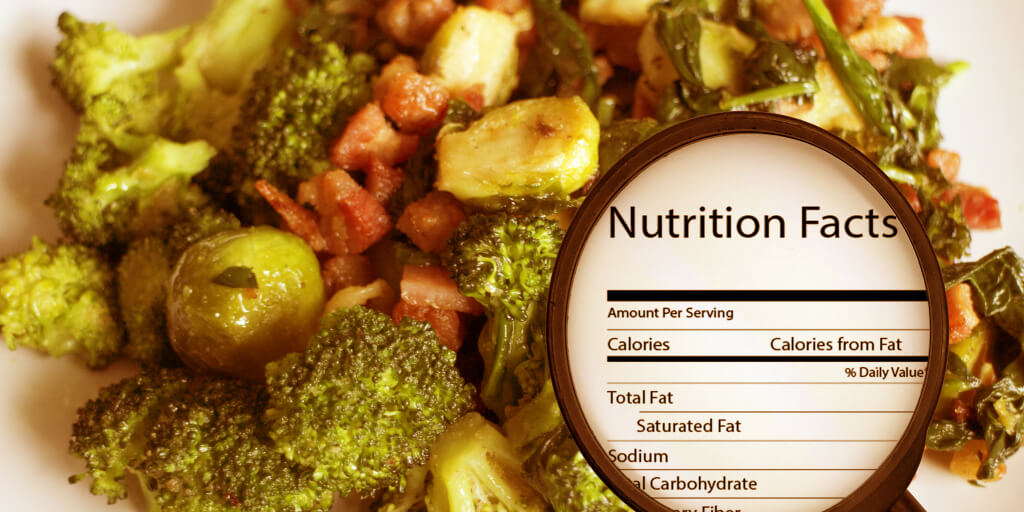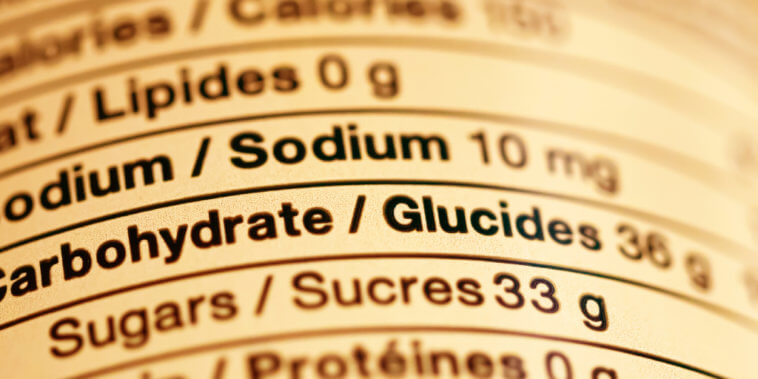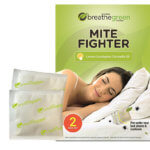When you shop for healthy foods, are you ever confused by the nutrition labels? If you said yes, you're not alone.
Many people don't understand what they should be looking for when they read that little black and white label on the side of their foods.
To start, we'll take a look at how the nutrition labels are calculated. Then we'll cover what you should look for on nutrition labels and how to choose the right foods for weight loss.

How are Nutrition Labels Calculated?
Nutrition labels are required by the FDA. So how exactly are nutrition labels calculated?
Originally, scientists used a special tool called a bomb calorimeter to break down the food. They then estimated the calorie count by how much energy the breakdown process released.
Now, the FDA requires food manufacturers to break down all of the components and nutrients in their food. Each food is broken down into the nutrients that contain energy. Protein, carbohydrates, fats, and alcohol all have unique caloric contents. The calorie count of our food is determined by the composition of the food.
However, these estimates can have a wide margin of error. FDA allows manufacturers a 20% tolerance on the nutrition information that they report. That means that 500 calorie dinner might actually be more like 600 calories.
While you might hope that the nutrition information was overestimated, it is more common to find that many foods are underestimated. When in doubt, err on the side of caution. You should listen to your body to make sure that you are getting the right amount of calories each day.

The First Thing You Should Look for on Nutrition Labels
The nutrition labels on foods can be overwhelming. Food manufacturers cram a ton of information into that small space. It can be confusing to know what to look for when you pick up an item at the grocery store.
The first thing you should look for on a nutrition label is the serving size. Many times, the label can be deceiving. Maybe you find the perfect, low-calorie salty snack. Only 100 Calories? Great!
But before you get too excited, you should take a closer look. What if this 100 Calories was only for a mouthful of food? If there's 5 servings per container, that changes the picture a bit.
Oftentimes, manufacturers will disguise high-calorie food by putting multiple servings in a single container. Many sugary sodas show only 120 calories per serving. But once you start looking a little deeper at the label, you will see that many soda cans have multiple servings in a container. While you may be thinking that a small bottle of soda only has 120 Calories, this bottle could have two to three servings. By the time you drink it, you actually consumed 240 to 360 empty calories.
Before you put that food in your grocery cart, take a look at the serving size on the nutrition label to truly understand how it will impact your diet.

How to Read Nutrition Labels for Weight Loss
Simply understanding nutrition labels is challenging sometimes. But understanding how to read nutrition labels for weight loss – is that even possible?
The answer is yes. Here's what you should be looking for to help choose healthier foods for weight loss.
First, you should always check the serving size. This helps you understand exactly how large the portions will be for the nutrition information listed. While this shouldn't determine your own personal portion size, it can give you a better understanding of how a typical portion contributes to your caloric intake for that day. Serving sizes help you calculate your calories accurately.
The next thing you should look at is the calories per serving. Remember that your weight loss is directly affected by how many calories you consume. No matter how hard you work out, consuming more calories than you burn will lead to weight gain.
You should also keep an eye on the fat and cholesterol levels on the nutrition label. The key here is to remember that you need healthy fats to survive and maintain your energy levels.
But there are bad fats that you need to watch out for.
If the nutrition label lists:
- Saturated fats
- Trans fats
- Cholesterol
Take a hard look at what the daily value percentages are. In general, you should steer clear of foods high in these nutrients to ensure that you maintain your healthy weight. Loading up on foods high in saturated fats, trans fats, and cholesterol can quickly derail your weight loss progress.
You should also watch for carbohydrates. Nutrition labels typically break down carbohydrates into fibers, sugars, and added sugars.
Like fats, keep in mind that not all carbohydrates are bad for you. In fact, you should look for foods that are high in dietary fiber.
These foods will keep you feeling fuller for longer and help you avoid the temptation of unhealthy convenience food.
However, you should opt for foods that are low in sugars. This includes naturally occurring sugars as well as added sugars. Sugars are just empty calories that can eventually get packed on to your waistline. Do your body a favor and cut these types of food out.
Incorporating protein-rich foods can also help boost your weight loss and rebuild muscle after intense workouts.Just make sure to read the entire label on protein-rich foods. Oftentimes, these foods are also packed full of saturated fats and trans fats. Shy away from processed dairy and opt for lean meats instead.
You should also take a look at the vitamins and minerals listed in the nutrition label. Getting your daily dose of all of the recommended vitamins is key to good health and weight loss. Look for healthy amounts of vitamin A and vitamin C. Calcium and iron-rich foods can also boost weight loss.
However, sodium-rich foods can really set you back. It is important to watch your sodium levels by checking the nutrition labels on the foods you choose. This will help keep your heart healthy and ready for those sweat sessions!

Do Food Products Have to List All Ingredients?
While it seems like manufacturers should be required to list all of the ingredients, they don't necessarily have to. While the FDA generally requires most ingredients to be listed, there are a few exceptions to this rule.
For example, if a company decides to include an ingredient that they consider a “trade secret”, they are not required to disclose it to consumers. The food industry is not the only industry that takes advantage of this rule. The cosmetic industry also uses the rule to avoid disclosing a comprehensive ingredients list to consumers.
But trade secret ingredients aren't the only exception to the rule.
Companies aren't required to list all ingredients if they qualify as a low-volume, small business. This means that companies with fewer than 100 full-time employees that produce less than 100,000 units don't have to list all of the ingredients.
And the bad news is that's not all.
Food sold in restaurants, as well as food served for immediate consumption, aren't required to disclose all of the ingredients in their food.
There is also an exception for food that in packaging that has less than 12 square inches of area to print on. For products that fall into this category, companies are only required to list contact information for consumers who wish to know the nutrition information.
The big picture isn't as transparent as it could be. Unfortunately, the FDA allows many exemptions that allow companies and food manufacturers to partially list or omit listing nutrition information and ingredients list.

What is the 5% and 20% Rule?
Understanding how to read a nutrition label can be challenging. Even with the tips and information that we've laid out for you, it can still be confusing.
The good news is that there is a method that you can use to help simplify this process.
The 5% and 20% rule helps to provide a baseline for which foods should be considered “healthy”. This rule is not comprehensive, but it helps to act as a general guideline for understanding the nutrition label.
When you're at the grocery store, take a look at the nutrition label on one of the products you're putting in your cart. If you look on the right-hand side of the column, you'll notice little percentages that correspond to the various nutrients in that product.
That percentage represents how much one serving of that food provides for each nutrient listed. Keep an eye out for key nutrients that affect your health like sodium, fiber, or trans fats.
In general, any nutrient with less than 5% of your daily value should be considered to be a low or insignificant amount of that nutrient. If you're looking for protein-rich foods, avoid products that provide 5% or less of this nutrient. On the other hand, if you see that a food contains less than 5% of your daily sodium need, then it may be a healthy choice for you.
If you spot any nutrients with 20% or greater, it is a good indicator that this food has substantial amounts of that nutrient. If you want to increase your daily fiber intake, look for foods that have greater than 20% listed for fiber content. However, if you spot food that has 20% of your daily fat intake, you may want to reconsider putting it in your cart.
Reading nutrition labels can be complicated – but it doesn't have to be. Learn how to choose the healthiest foods for your weight loss journey by reading the nutrition labels as you shop.
Sources:
https://fyi.extension.wisc.edu/foodsense/2013/05/28/5-20-label-rule/
https://www.scientificamerican.com/article/how-do-food-manufacturers/
https://www.sharecare.com/health/nutrition-diet/first-look-food-labels
https://whatsgood.vitaminshoppe.com/how-to-read-a-nutrition-label/
https://www.verywellfit.com/read-nutrition-labels-for-weight-loss-4065403




Comments
Loading…